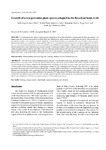Please use this identifier to cite or link to this item:
http://www.alice.cnptia.embrapa.br/alice/handle/doc/533622| Title: | Growth of seven perennial plant species adapted to the Brazilian Semi-Arid. |
| Authors: | SILVA, P. S. L. e  SILVA, K. M. B. e   LOBO, R. N. B.   SILVA, P. I. B.   |
| Affiliation: | PAULO SÉRGIO LIMA E SILVA KATHIA MARIA BARBOSA E SILVA RAIMUNDO NONATO BRAGA LOBO, CNPC PAULO IGOR BARBOSA E SILVA. |
| Date Issued: | 2007 |
| Citation: | Acta Botânica Brasílica, v. 21, n. 4, p. 935-941, 2007. |
| Description: | Abstract: Growth of seven perennial plant species adapted to the Brazilian Semi-Arid. Abstract - Measuring plant height (y) and canopy diameter (x) in trees may not be an easy task, but stem diameter (z) can be more easily evaluated. This work's objective was two-fold: evaluate the growth of species adapted to the Brazilian Semi-Arid Region in the first two years of age, and obtain linear equations to estimate y and x from z, in those species. A random block design with four replications was employed. The values for x, z, and y were measured biannually from October/2003 to March/2005. Prosopis juliflora and Mimosa caesalpiniaefolia showed the highest stem diameter and plant height values, respectively, and both showed the highest canopy diameter. In the equations to estimate plant height from the stem diameter the value of the coefficient of determination (R2) ranged from 0.76 (Tamarindus indica and Leucaena leucocephala) to 0.92 (Prosopis juliflora and Azadirachta indica). In the equations that allowed to estimate the crown diameter from the stem diameter the R2 value ranged from 0.70 (Leucaena leucocephala) to 0.92 (Azadirachta indica). Resumo: A mensuração da altura da planta (y) e do diâmetro da copa (x) em árvores pode não ser tarefa fácil, mas o diâmetro do caule (z) pode ser avaliado mais facilmente. Este trabalho teve por objetivos avaliar o crescimento de espécies adaptadas ao Semi-Árido brasileiro, nos primeiros dois anos de idade, e obter equações lineares para estimar y e x a partir de z, nessas espécies. Utilizou-se o delineamento de blocos ao acaso com quatro repetições. Os valores de x, z e y foram medidos semestralmente de outubro/2003 a março/2005. Prosopis juliflora e Mimosa caesalpiniaefolia apresentaram os maiores diâmetros do caule e altura da planta, respectivamente, e ambas apresentaram o maior diâmetro da copa. Nas equações para estimar a altura da planta a partir do diâmetro do caule, o valor do coeficiente de determinação (R2) variou de 0,76 (Tamarindus indica and Leucaena leucocephala) a 0,92 (Prosopis juliflora and Azadirachta indica). Nas equações que permitiram estimar o diâmetro da copa a partir do diâmetro do caule, o valor de R2 variou de 0,70 (Leucaena leucocephala) a 0,92 (Azadirachta indica). |
| Thesagro: | Algaroba Caatinga Azadirachta Indica Leucaena Leucocephala Nim Mimosa Caesalpiniaefolia Sabiá Tamarindo Tamarindus Indica |
| NAL Thesaurus: | Plant characteristics Regression analysis Semiarid zones Brazil |
| Keywords: | Prosopis julifflora Estatura da planta Análise de regressão Diâmetro do caule Diâmetro da copa Brasil Canopy diameter Plant height Stem diameter Tree height |
| DOI: | http://dx.doi.org/10.1590/S0102-33062007000400018. |
| Notes: | Título em português: Crescimento de sete espécies vegetais perenes adaptadas ao Semi-Árido brasileiro. |
| Type of Material: | Artigo de periódico |
| Access: | openAccess |
| Appears in Collections: | Artigo em periódico indexado (CNPC)  |
Files in This Item:
| File | Description | Size | Format | |
|---|---|---|---|---|
| APIGrowthofseven.pdf | 59.46 kB | Adobe PDF |  View/Open |









